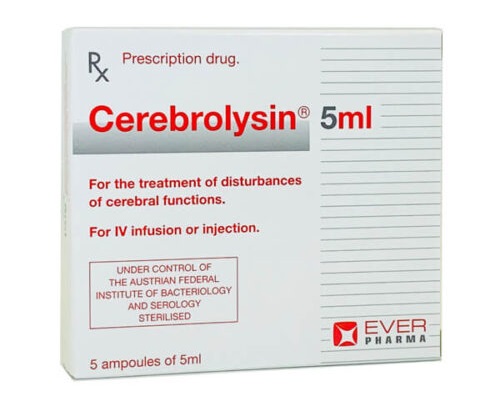Description
Tradename:
Cerebrolysin
Compound:
Each 1 ml of solution contains:
Cerebrolysin concentrate (peptide complex) 215.2 mg
Properties:
Nootropic drug.
Cerebrolysin contains low molecular weight biologically active neuropeptides that penetrate the BBB and directly enter nerve cells. The drug has an organ-specific multimodal effect on the brain, i.e. it provides metabolic regulation, neuroprotection, functional neuromodulation and neurotrophic activity.
Metabolic regulation: Cerebrolysin increases the efficiency of aerobic energy metabolism of the brain, improves intracellular protein synthesis in the developing and aging brain.
Neuroprotection: the drug protects neurons from the damaging effects of lactic acidosis, prevents the formation of free radicals, increases survival and prevents the death of neurons under conditions of hypoxia and ischemia, reduces the damaging neurotoxic effect of excitatory amino acids (glutamate).
Neurotrophic activity: Cerebrolysin is the only nootropic peptidergic drug with proven neurotrophic activity, similar to the action of natural neuronal growth factors (NGF), but manifested under conditions of peripheral administration.
Functional neuromodulation: the drug has a positive effect in cases of cognitive impairment on memory processes.
Indications:
-Alzheimer’s disease;
-dementia syndrome of various origins;
– chronic cerebrovascular insufficiency;
-ischemic stroke;
-traumatic injuries of the brain and spinal cord;
– mental retardation in children;
-disorders associated with attention deficit in children;
– endogenous depression, resistant to antidepressants (as part of complex therapy).
Directions for use and dosage:
The drug is used parenterally. The dose and duration of use depend on the nature and severity of the disease, as well as the age of the patient. A single administration of the drug in a dose of up to 50 ml is possible, but a course of treatment is more preferable.
The recommended course of treatment is daily injections for 10-20 days.
Cerebrolysin is used parenterally in the form of intramuscular injections (up to 5 ml) and intravenous injections (up to 10 ml). The drug in a dose of 10 ml to 50 ml is recommended to be administered only through slow intravenous infusions after dilution with standard solutions for infusion. The duration of infusions ranges from 15 to 60 minutes.
Contraindications:
-severe renal failure;
– status epilepticus;
– increased sensitivity to the drug.
Precautionary measures:
If the injections are performed too quickly, a feeling of heat, sweating, and dizziness may occur. Therefore, the drug should be administered slowly.
Clinical studies have shown that Cerebrolysin does not affect the ability to drive vehicles and use machinery.
Side effects:
From the immune system: very rarely – increased individual sensitivity, allergic reactions.
Mental disorders: rarely – the supposed activation effect is accompanied by agitation, manifested by aggressive behavior, confusion, and insomnia.
From the nervous system: rarely – too rapid administration of the drug can lead to dizziness; very rarely – isolated cases of generalized epilepsy and one case of seizures were associated with Cerebrolysin.
From the cardiovascular system: very rarely – too rapid administration of the drug can lead to increased heart rate and arrhythmia.
From the digestive system: very rarely – dyspepsia, diarrhea, constipation, nausea, vomiting; rarely – loss of appetite.
From the skin and subcutaneous tissues: very rarely – skin reactions; rarely – with excessively rapid administration, a feeling of heat, sweating, and itching may occur.
General disorders and disorders at the injection site: very rarely – redness, itching.
Storage method:
Store at a temperature no higher than 25 degrees in a dark place.
Package:
The cardboard box contains 5 ampoules of 5 ml and paper instructions.









